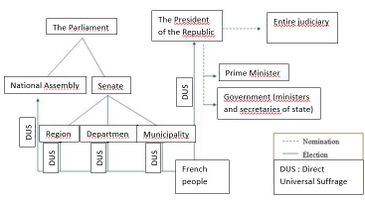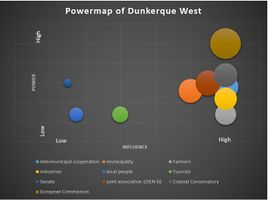COLAND Case Study 2020 - Dunkerque (West)
>>>back to working groups overview
Rationale
- Why do you think this case is relevant? What is your hypothesis considering the landscape challenges?
- Format: 3-4 sentences
Location and scope
You can edit this map with the map editor
A Landscape System Analysis
A.1 Landscape layers and their system context
Geomorphology, landscape units and coastal typology
- Description of evolution, status quo and driving forces, is the coastal typology changing? Why is that? (approx 200 signs)
- add 1-2 graphical representations to the image gallery, you can add more if you like
- Yourcase landscapeunits1.jpg
add a caption
- Yourcase landscapeunits2.jpg
add a caption
Land use
- settlements, infrastructure, agriculture, resource extraction, natural areas, energy production...
- description of evolution, status quo and driving forces, is the land use likely to change? Why is that? (approx 200 signs)
- add 1-2 graphical representations to the image gallery, you can add more if you like
- Yourcase landuse1.jpg
add a caption
- Yourcase landscapeunits2.jpg
add a caption
- Yourcase landscapeunit3.jpg
add a caption
Green/blue infrastructure
- What are the major potential elements of a green/blue infrastructure network? Are these likely to change/disappear? Why is that?
- You find my background material on green infrastructure in our reading list
- add 1-2 graphical representations to the image gallery, you can add more if you like
- Your case green blue infrastructure1.jpg
add a caption
- Your case green blue infrastructure2.jpg
add a caption
Actors and stakeholders
'Our area covers the borough of Dunkirk as well as the borough of Saint-Omer. In this area, we are dealing with a group of municipalities called "Dunkerque Grand Littoral". This inter-municipal cooperation brings together 17 municipalities and its competences revolve around economic development, waste management, town planning, mobility and transport, energy, water management and sanitation, housing and roads. Finally, it intervenes in the fields of health, sport, justice, education, major risks and accessibility. This cooperative is managed by a President and its Vice-Presidents. This cooperation can therefore be considered as the leading player in the area. In the commune of Saint-Omer, which represents only a small part of our area, we find the Platier d'Oye national nature reserve. It is managed by the EDEN 62 mixed syndicate, which brings together, on an equal footing, elected members of the Departmental Council and local authorities. This syndicate is a will of the Pas-de-Calais Department and its missions are to protect, develop and raise awareness.'
Then the second player would be represented by the various mayors of these 17 communes. They play a double role: state agent and commune agent. As an agent of the state, the mayor fulfils the following administrative functions: - the publication of laws and regulations - the organisation of elections - the legalization of signatures. It may be responsible for the execution of general security measures. As an agent of the municipality, he is responsible for the execution of the decisions of the municipal council and acts under the control of this council. He represents the municipality in court, awards contracts, signs contracts, prepares the budget, and manages the assets. In the area of town planning, he issues building permits and other town planning authorisations on behalf of the municipality. By its municipal by-laws, it can regulate traffic, parking, bathing and navigation in its municipality or prescribe works in case of endangerment of the population or the environment.
Finally, the third and last actor is the people living and working in the area, not forgetting tourists. Thus, we find the port of Dunkirk and all the workers associated with it. It should be noted that this port is classified as France's 3rd largest port, renowned as a port for large bulk goods destined for its many industrial establishments. In other words, it plays an essential role in the landscape. There are also many commercial zones within our study area, which also impact the landscape. The farmers who structure the landscape with their plots of land cannot be overlooked either. Finally, let us not forget of course the inhabitants who live the landscape on a daily basis, as well as the tourists who impact the landscape to a greater or lesser extent depending on their presence.
So it can therefore be said here that it is the inhabitants and workers (mainly farmers) who are affected by the changes made to the landscape. Nor should we forget the local fauna and flora that depend on the actions initiated in the landscape. Hence the importance of having protected areas such as the Platier d'Oye Nature Reserve.
Sacred spaces and heritage
- Which places/elements hold cultural value and to whom?
- You may add a map and some images, please also explain in your caption why these elements are valuable
- Your case sacredspace1.jpg
add a caption
- Your case sacredspace2.jpg
add a caption
- Your case sacredspace3.jpg
add a caption
Visual appearance and landscape narrative
- Which elements are essential for the landscape character?
- Has the landscape been painted or otherwise depicted, when and whom? Which elements are essential?
- Which narratives exist? Who has written about this landscape or depicted it in some way?
- You can add text and images
- Your case character1.jpg
add a caption
- Your case character2.jpg
add a caption
- Your case character3.jpg
add a caption
A.2 Summary of your landscape system analysis and your development targets
- You can summarize your findings with an DPSI(R) Model or a Spider Diagram
- Link back to the Sustainable Development Goals: Which goals are at risk?
- What is your hypothesis for this landscape?
- Visualise your hypothesis with one graphic/pict
- Are there any existing initiatives taking action in this landscape? Do you have a critical perspective on that?
- Add text and visuals
- Your case your spider diagram or dpsir model.jpg
explain your analysis briefly in the caption
- Your case your hypothesis visual.jpg
explain your hypthesis briefly in the caption
A.3 Theory reflection
- Reflect on at least three international policy documents in relation to their local landscape case
- choose one international, one European and one national document
- You can choose references from our reading list
- Scope: 250 words
A.4 References
- give a full list of the references you have used for this section
Phase B: Landscape Evaluation and Assessment
B.1 Assessment Strategy
- Based on the hypothesis derived from your previous landscape systems analysis you are now asked to define the goals for assessing the landscape. Your assessment is the basis for evaluating the landscape status.
- Which elements and phenomena need to be mapped, why and how?
- This a text contribution, max 250 words
B.2 Mapping
- As defined by your assessment strategy you conduct the mapping and present your findings here
- As a minimum, at least three different themes need to be mapped, you may choose more if needed
- Your case your assessment mapping themel.jpg
briefly explain the findings of your mapping
- Your case your assessment mapping theme2.jpg
briefly explain the findings of your mapping
- Your case your assessment mapping theme3.jpg
briefly explain the findings of your mapping
B.3 Problem definition and priority setting
- Give a summary of the major findings of your mapping process, what are the problems/potentials identified?
- Draw a problems/potentials map
- Set priorities for the most relevant issues
- Your case problems potentials map.jpg
add caption here
B.4 Theory reflection
- Please reflect the assessment and evaluation methods used based on at least three readings
- Did you encounter limitations'
- 200 words test contribution
B.5 References
- give a full list of the references you have used for this section
Phase C – Strategy and Master Plan
C.1 Goal Setting
- Define strategic planning objectives based on the evaluation findings
- Link back to your original targets from section one and the Development Goals
- 150 words text contribution
C.2 Spatial Strategy and Transect
- translate your strategic goals into a vision
- develop a spatial translation of your vision
- exemplify your vision in the form of a transect with concrete interventions
- add map(s) and visualizations
- Your case spatial translaton vision.jpg
add caption here
- Your case transect.jpg
add caption here
- Your case transect detail1.jpg
add caption here
- Your case transect detail2.jpg
add caption here
C.3 From Theory of Change to Implementation
- For implementing your vision: Which partnerships are needed? Which governance model is required?
- Who needs to act and how? Draw and explain a change/process model/timeline
- Which resources are needed? On which assets can you build?
- add 150 words text and visuals
- Your case spatial your governance model.jpg
add caption here
- Your case spatial your process model.jpg
add caption here
C.4 References
- give a full list of the references you have used for this section
D. Process Reflection
- Reflect in your intercultural and interdisciplinary team on the outcomes of your study
- Which limitations were you facing?
- What have you learnt from each other?
- What would you do differently next time?
- You can also use diagrams/visuals
- 250 words text


